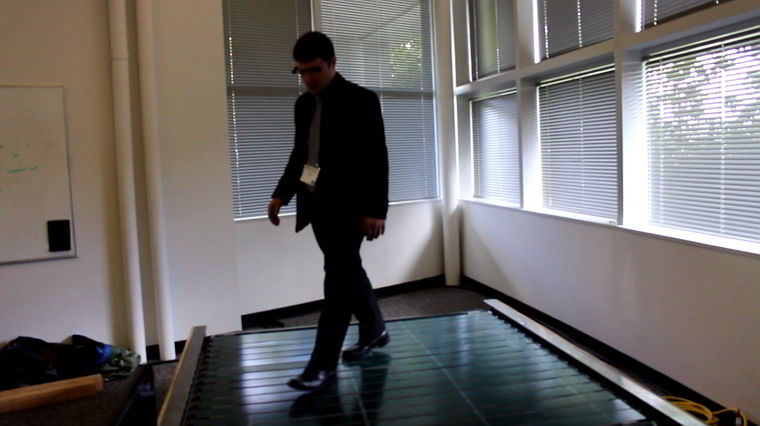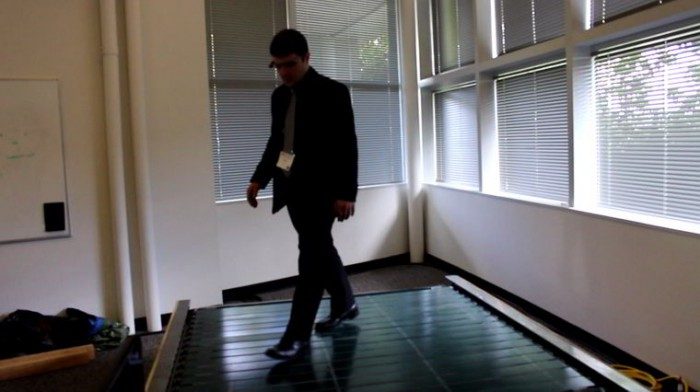Infinadeck is a new entrant into the omnidirectional treadmill space for VR use. The device allows a user to walk completely naturally in any direction. Unlike other VR treadmills that have sprung up recently, the Infinadeck is an active, rather than passive, solution to the problem of VR locomotion.
Bats? Omnidirectional Treadmills? It’s All Just Engineering.
Having seen what, to my eyes, appeared to be a very complex piece of machinery, I would have never thought that the Infinadeck treadmill was designed and built by one guy—in his spare time. George Burger, the inventor of Infinadeck, is the also Director of New Product Development for Louisville Slugger, the baseball bat brand. He designs the machines that make the bats.
When I asked him, quite amazed, how he managed to build this monstrous device on his own, he stared at me puzzled, like I’d just asked him how he managed to tie his shoelaces. From the looks of the individual belts running along a tank-tread-like conveyor, I had assumed that each belt was powered by an individual motor. Burger went on to explain that the Infinadeck omnidirectional treadmill is powered by just two motors—so much for my engineering intuition.
In reality, the device consists of just one belt that is looped in such a way that it comes out straight on top, giving the appearance of many belts that run perpendicular to the direction of the conveyor. Using one belt instead of many has two huge benefits. First, the belt can be powered by one motor instead of multiple, hugely cutting cost. Second, a single belt provides a constant speed across the entire system, with no need to sync motor RPM—very important for safely walking on this massive machine. By combining the motion of these perpendicular systems with the vector of the user’s direction, Infinadeck lets you walk in any direction using a single platform.
Walking on Infinadeck and Challenges With Active Omnidirectional Treadmills
I got to walk on the Infinadeck at the SVVR Conference & Expo last week. For now, it lacks the ability to detect a user’s direction and speed. Instead, Burger manually controlled those values using two makeshift dials. Using my arms I indicated to him which direction I wanted to turn, and he adjusted the vector slowly as I rotated.
When I wasn’t rotating, it worked very well. No matter what direction I was facing, walking was natural and seamless. Manual rotation in symphony with Burger was a bit precarious, a few times I nearly lost balance (I can’t imagine it being too fun to fall onto this beast). At the conference there wasn’t any safety ring around the user, but this is apparently in the works. A safety rig to prevent the user from falling will definitely be necessary for virtual reality use.
Other VR treadmills like the Virtuix Omni and Cyberith have taken a passive approach to omnidirectional motion. They use low-friction surfaces to facilitate locomotion rather than moving parts. The passive approaches reduce size, cost, and complexity, but may not be as natural as walking on a moving surface.
The usefulness of Infinadeck will come down to how well the user’s direction and speed can be detected and compensated for. If it’s off by just a bit, losing balance becomes a very real possibility. Not being able to see your legs in a virtual reality environment (occluded by a VR headset) would make this even more difficult.
Momentum could be another problem for the prototype. Due to its heft, there’s no way I could see the prototype working for a jogging pace followed by a quick stop; the parts likely wouldn’t be able to stop fast enough to keep the user from losing balance. However, Burger says that he built Infinadeck with scalability in both size and manufacturing in mind. A production model, he said, could be much lighter, and perhaps more responsive. Noise was also a problem that Burger said would be improved in a production model which would use plastic gears instead of chain sprockets.
Assuming the parts can stop fast enough, sensing user speed and direction will be vital. A solution as laggy and jumpy as the Kinect could never work. Infinadeck will need something with a lighting fast sampling rate and incredible accuracy if they want to preserve completely natural walking motion.








